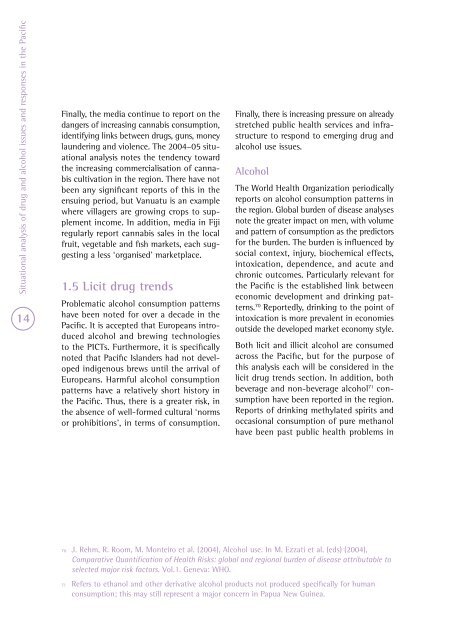rp21 situational analysis - Pacific Health Voices
rp21 situational analysis - Pacific Health Voices
rp21 situational analysis - Pacific Health Voices
You also want an ePaper? Increase the reach of your titles
YUMPU automatically turns print PDFs into web optimized ePapers that Google loves.
Situational <strong>analysis</strong> of drug and alcohol issues and responses in the <strong>Pacific</strong><br />
14<br />
Finally, the media continue to report on the<br />
dangers of increasing cannabis consumption,<br />
identifying links between drugs, guns, money<br />
laundering and violence. The 2004–05 <strong>situational</strong><br />
<strong>analysis</strong> notes the tendency toward<br />
the increasing commercialisation of cannabis<br />
cultivation in the region. There have not<br />
been any significant reports of this in the<br />
ensuing period, but Vanuatu is an example<br />
where villagers are growing crops to supplement<br />
income. In addition, media in Fiji<br />
regularly report cannabis sales in the local<br />
fruit, vegetable and fish markets, each suggesting<br />
a less ‘organised’ marketplace.<br />
1.5 Licit drug trends<br />
Problematic alcohol consumption patterns<br />
have been noted for over a decade in the<br />
<strong>Pacific</strong>. It is accepted that Europeans introduced<br />
alcohol and brewing technologies<br />
to the PICTs. Furthermore, it is specifically<br />
noted that <strong>Pacific</strong> Islanders had not developed<br />
indigenous brews until the arrival of<br />
Europeans. Harmful alcohol consumption<br />
patterns have a relatively short history in<br />
the <strong>Pacific</strong>. Thus, there is a greater risk, in<br />
the absence of well-formed cultural ‘norms<br />
or prohibitions’, in terms of consumption.<br />
Finally, there is increasing pressure on already<br />
stretched public health services and infrastructure<br />
to respond to emerging drug and<br />
alcohol use issues.<br />
Alcohol<br />
The World <strong>Health</strong> Organization periodically<br />
reports on alcohol consumption patterns in<br />
the region. Global burden of disease analyses<br />
note the greater impact on men, with volume<br />
and pattern of consumption as the predictors<br />
for the burden. The burden is influenced by<br />
social context, injury, biochemical effects,<br />
intoxication, dependence, and acute and<br />
chronic outcomes. Particularly relevant for<br />
the <strong>Pacific</strong> is the established link between<br />
economic development and drinking patterns.<br />
70 Reportedly, drinking to the point of<br />
intoxication is more prevalent in economies<br />
outside the developed market economy style.<br />
Both licit and illicit alcohol are consumed<br />
across the <strong>Pacific</strong>, but for the purpose of<br />
this <strong>analysis</strong> each will be considered in the<br />
licit drug trends section. In addition, both<br />
beverage and non-beverage alcohol 71 consumption<br />
have been reported in the region.<br />
Reports of drinking methylated spirits and<br />
occasional consumption of pure methanol<br />
have been past public health problems in<br />
70 J. Rehm, R. Room, M. Monteiro et al. (2004), Alcohol use. In M. Ezzati et al. (eds) (2004),<br />
Comparative Quantification of <strong>Health</strong> Risks: global and regional burden of disease attributable to<br />
selected major risk factors. Vol.1. Geneva: WHO.<br />
71 Refers to ethanol and other derivative alcohol products not produced specifically for human<br />
consumption; this may still represent a major concern in Papua New Guinea.
















